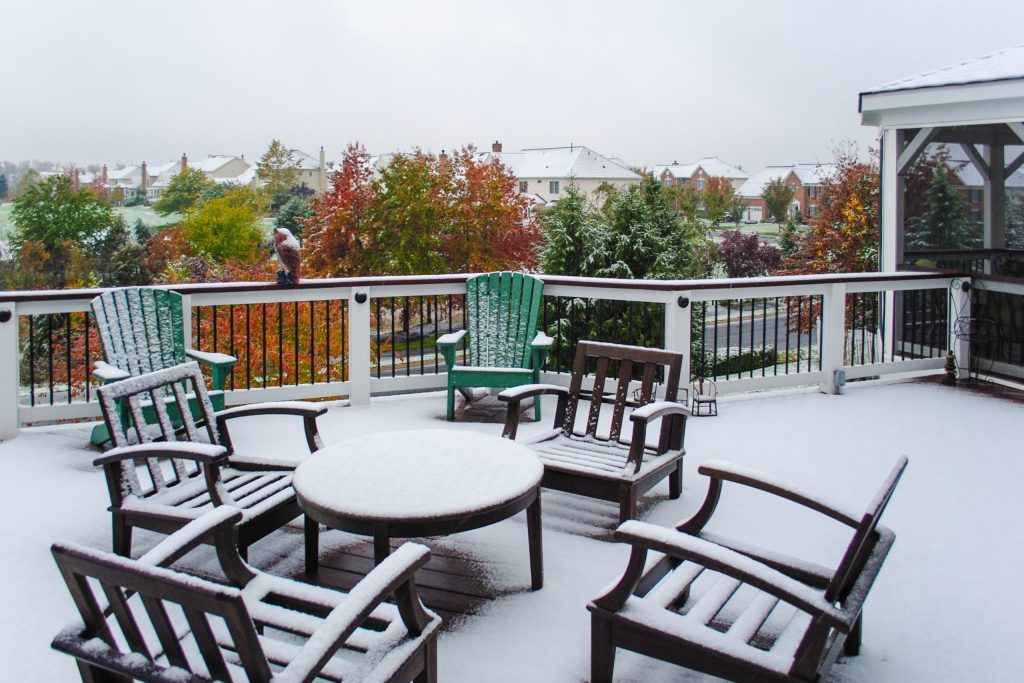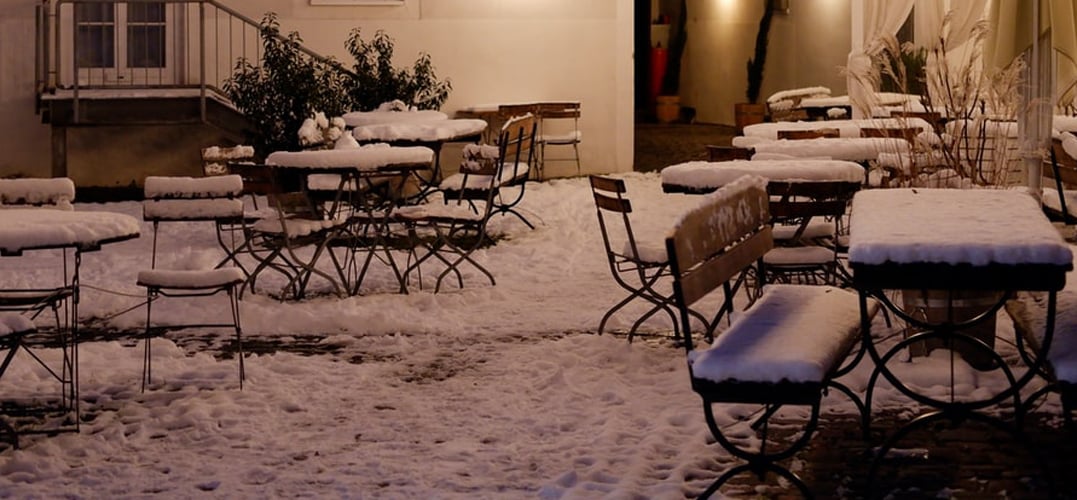Winter doesn’t have to mean saying goodbye to your beautiful outdoor dining space. With the right preparation and strategies, you can winterize your outdoor dining space to protect your investment and even continue entertaining throughout the colder months. Whether you’re looking to preserve your furniture for spring or create a cozy winter gathering spot, this comprehensive guide will walk you through everything you need to know.
Why Winterizing Your Outdoor Dining Space Matters
Proper winterization protects your outdoor furniture, extends its lifespan, and saves you money on replacements. More importantly, it preserves the heart of your outdoor entertainment area so you can jump right back into hosting when warmer weather returns. Without proper winter preparation, exposure to snow, ice, and freezing temperatures can cause cracking, fading, rust, and structural damage to even the highest-quality outdoor furniture.
Assess Your Current Outdoor Dining Setup
Before diving into winterization, take inventory of what you’re working with. Walk through your outdoor dining space and categorize your items:
Furniture pieces include dining tables, chairs, benches, and any decorative seating. Note the materials – teak, aluminum, wicker, or composite materials each require different care approaches.
Accessories and decor encompass cushions, umbrellas, planters, lighting fixtures, and table decorations. These items are often the most vulnerable to winter damage but also the easiest to protect.
Built-in features such as outdoor kitchens, fire pits, or permanently installed lighting need special attention but can’t be moved to storage.
Cleaning: The Foundation of Winter Protection
Deep cleaning before winter protection is crucial. Dirt, debris, and moisture trapped under covers can cause more damage than exposure to the elements.
Start with a thorough sweep of your entire dining area, removing leaves, dirt, and any organic matter that could attract pests or promote mold growth. For furniture, use appropriate cleaners for each material type. Teak furniture benefits from specialized teak cleaners, while aluminum pieces can be cleaned with mild soap and water. Pay special attention to joints, crevices, and hardware where moisture and debris tend to accumulate.
Don’t forget to clean fabric elements like cushions and umbrellas. Remove cushion covers and wash according to manufacturer instructions. For umbrellas, open them fully, clean the fabric with appropriate cleaners, and ensure they’re completely dry before storage.
Furniture Protection Strategies
The approach you take depends on your climate, storage options, and furniture materials. You have three main strategies to choose from, and often a combination works best.
Storage is the gold standard for furniture protection. If you have garage, basement, or shed space, bringing furniture indoors provides complete protection from winter elements. When storing, ensure pieces are clean and dry, and consider using furniture pads to prevent scratching. Stack chairs carefully and store table leaves separately if applicable.
High-quality covers offer excellent protection when storage isn’t possible. Invest in breathable, waterproof covers specifically designed for outdoor furniture. Avoid plastic tarps, which can trap moisture and cause mold or mildew. Look for covers with ventilation features and secure tie-downs to withstand winter winds.
Strategic positioning can significantly reduce winter damage even without covers. Move furniture to protected areas like covered patios, against south-facing walls, or under overhangs. Group lightweight pieces together and anchor them to prevent wind damage.

Material-Specific Winter Care
Different furniture materials require tailored approaches to winter protection.
Teak furniture is naturally weather-resistant but benefits from annual oiling before winter. Clean thoroughly, apply teak oil if desired (though not necessary), and either store or cover. Teak can actually weather beautifully if left uncovered, developing a silver-gray patina that many homeowners prefer.
Aluminum and metal furniture should be checked for any chips in powder coating or paint. Touch up any damaged areas to prevent rust, then clean and either store or cover. Pay special attention to joints and hardware, applying a light coat of appropriate lubricant if recommended by the manufacturer.
Wicker and rattan pieces are more vulnerable to moisture damage. These should ideally be stored indoors, but if that’s not possible, ensure covers are breathable and check periodically throughout winter for any signs of moisture buildup.
Plastic and resin furniture is generally winter-hardy but can become brittle in extreme cold. Avoid stacking these pieces in freezing temperatures, and store them in a way that prevents warping from uneven weight distribution.
Protecting Fabric Elements and Accessories
Cushions, pillows, and fabric accessories require special attention during winterization. Remove all fabric elements from your outdoor dining space before the first freeze. Even “all-weather” fabrics perform better with proper winter storage.
Wash all removable covers according to manufacturer instructions and ensure they’re completely dry before storage. Store cushions in a dry, ventilated area, preferably standing on edge rather than stacked flat to maintain their shape and allow air circulation.
For umbrellas, ensure they’re completely clean and dry before storage. Store them in a horizontal position if possible, or use an umbrella storage bag designed for the purpose. Never store a damp umbrella, as this can lead to mold, mildew, and fabric deterioration.
Winterizing Built-In Features
Permanent installations require different strategies but are equally important to protect.
Outdoor kitchen components need thorough cleaning and proper shutdown procedures. Disconnect and drain water lines to prevent freezing and pipe damage. Clean and cover grills, refrigerators, and other appliances according to manufacturer specifications. Many outdoor kitchen owners invest in custom covers or enclosures for comprehensive protection.
Fire pits and fireplaces should be cleaned of all ash and debris. Cover the fire pit with a waterproof cover that allows for ventilation, or if it’s a permanent installation, ensure proper drainage so water doesn’t pool in the fire bowl.
Lighting systems may need bulb removal in extreme climates to prevent freeze damage. LED lights are generally more cold-hardy than traditional bulbs, but check manufacturer recommendations for your specific fixtures.
Creating a Winter-Ready Entertaining Space
Just because you’re winterizing doesn’t mean you have to completely abandon your outdoor dining dreams. With some planning, you can create a winter-ready space that allows for cold-weather entertaining.
Consider investing in outdoor heaters to extend your entertaining season. Propane patio heaters, electric infrared heaters, or even a fire pit can make outdoor dining comfortable well into winter months. When selecting heaters, prioritize safety features and ensure adequate ventilation for fuel-burning models.
Wind protection becomes crucial in winter entertaining. Temporary windscreens, outdoor curtains, or even strategically placed planters can create a more comfortable microclimate around your dining area.
For furniture that stays outside, consider weather-resistant seat cushions and throws that can be easily brought indoors after each use. This allows you to add comfort without leaving vulnerable items exposed to the elements.
Maintenance Throughout Winter
Winterization isn’t a set-it-and-forget-it process. Regular winter maintenance ensures your protection strategies remain effective throughout the cold months.
After significant storms, check covers for damage, water pooling, or displacement. Heavy snow loads can damage even high-quality covers, so gently remove excess snow when safe to do so. However, never attempt to remove ice, as this can cause more damage than leaving it in place.
On warmer winter days, consider briefly removing covers to allow air circulation and check for any moisture buildup. This is especially important in climates with frequent freeze-thaw cycles.
If you’re storing furniture indoors, periodically check storage areas for signs of pests, moisture, or temperature fluctuations that could affect your furniture.
Preparing for Spring Transition
Planning your spring setup during winter makes the transition smoother and helps you identify any issues early.
Create a checklist of items to inspect when bringing furniture out of storage, including hardware tightness, fabric condition, and any signs of pest damage. This is also an excellent time to plan any repairs or replacements needed for the upcoming season.
Consider scheduling professional maintenance for complex items like outdoor kitchen appliances or elaborate lighting systems. Many service providers offer better rates and availability during their off-season.

Regional Considerations for Winter Protection
Your winterization strategy should reflect your local climate conditions.
Mild winter regions might focus more on protecting against increased rainfall and occasional temperature drops rather than extreme cold and snow. UV protection remains important even in winter in sunny climates.
Harsh winter areas require more comprehensive protection strategies, with indoor storage being the preferred option for most furniture types. In these regions, the investment in quality storage solutions pays dividends in furniture longevity.
Coastal areas face unique challenges from salt air and high humidity even in winter. These environments require frequent cleaning and may benefit from additional protective treatments for metal components.
Cost-Effective Winterization Solutions
Protecting your outdoor dining space doesn’t have to break the bank. Prioritize protection for your most valuable or vulnerable pieces first. A high-quality cover for an expensive dining set is a better investment than cheap covers for everything.
Consider DIY solutions for basic protection, such as using furniture pads or blankets under covers for additional insulation, or creating simple storage solutions in existing spaces like garages or basements.
Group buying with neighbors can make high-quality covers more affordable, especially if you have similar furniture pieces. Many manufacturers offer volume discounts for multiple cover purchases.
The Long-Term Benefits
Proper winterization is an investment in your outdoor living space that pays dividends for years to come. Well-maintained outdoor furniture retains its appearance and functionality far longer than neglected pieces, ultimately saving money on premature replacements.
More importantly, a properly winterized space means you can dive right back into outdoor entertaining as soon as spring weather arrives, without spending time and money on repairs or replacements.
Taking the time to properly winterize your outdoor dining space ensures that when warm weather returns, your outdoor oasis will be ready to welcome family and friends for another season of memorable gatherings. The effort you put in now will reward you with years of beautiful, functional outdoor dining experiences.
Whether you choose comprehensive storage, strategic covering, or a combination approach, the key is consistency and attention to your specific climate and furniture needs. Your future self will thank you when spring arrives and your outdoor dining space is ready for another season of entertaining in style.
